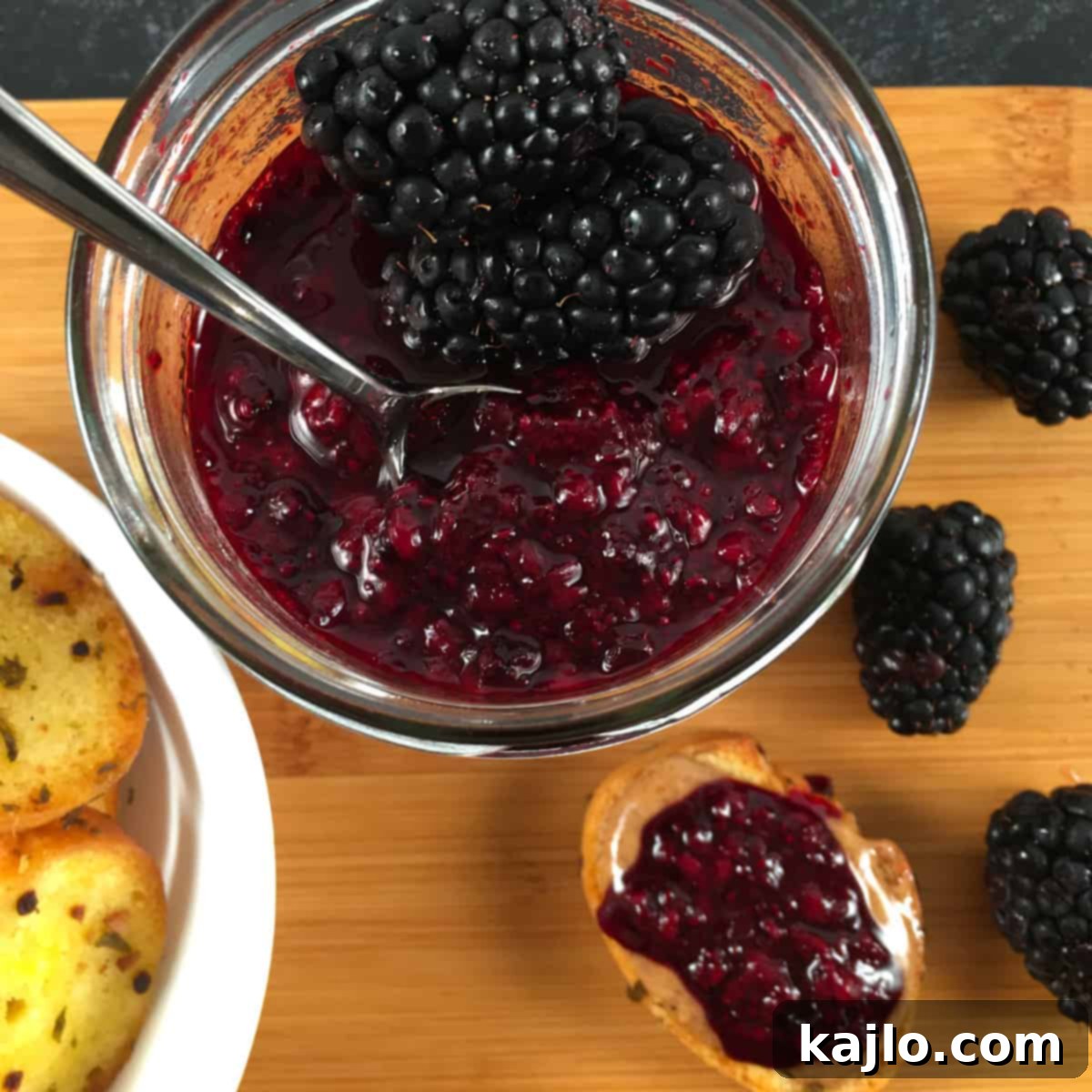Homemade Marionberry Jam: A Low Sugar, No Pectin Recipe for the “Cabernet of Blackberries”
Ever had the pleasure of tasting a marionberry? These luscious berries, often hailed as the “Cabernet of blackberries” for their exceptionally rich and complex flavor, are a true Oregon treasure. In this comprehensive guide, we’re diving into an incredibly simple marionberry jam recipe that’s not only low in sugar but also beautifully thickened with chia seeds – no pectin required! Get ready to infuse your meals with the vibrant purple hue and delectable taste of fresh marionberry jam, perfect for spreading on virtually everything.
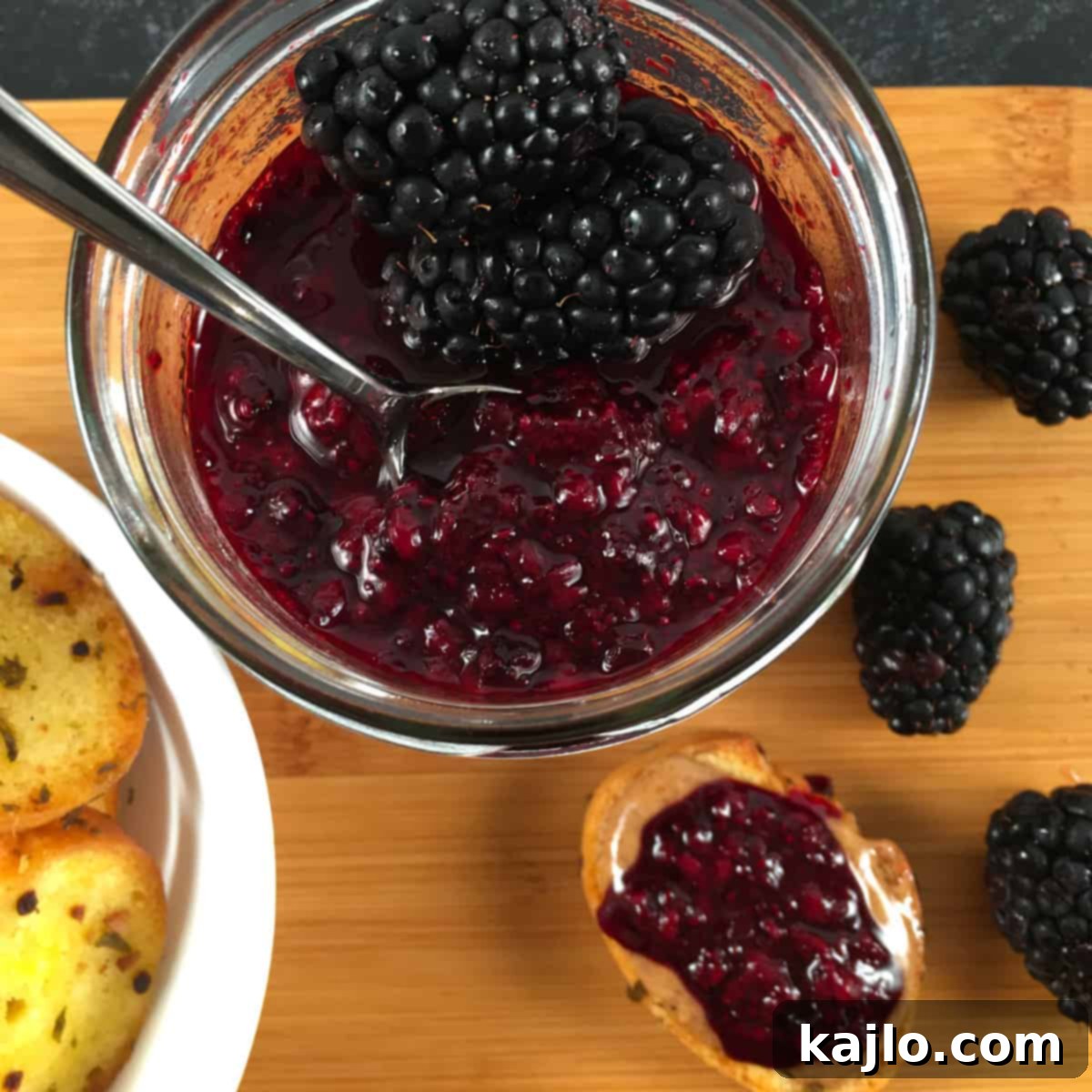
Discovering new foods is an exciting culinary adventure, and marionberries have recently become a delightful addition to my kitchen. This low sugar marionberry jam is a direct result of that discovery, designed to celebrate the berry’s natural taste with minimal fuss. When encountering a new ingredient, I always lean towards straightforward recipes that allow the core flavor to shine through. Had fresh marionberries been available, I might have simply enjoyed them raw. However, frozen marionberries provide a fantastic opportunity to create this easy, spreadable fruit preserve any time of year.
This simple jam recipe is all about maximizing the natural goodness of marionberries. The quality of your berries will directly influence the final taste, so choosing good frozen marionberries (or fresh if you’re lucky enough to live in Oregon) is key. You might be wondering where to find these unique berries. Don’t worry, even if you’re far from Oregon, you can still enjoy this delightful spread. Frozen berries make it possible to capture the essence of summer all year long, ensuring you can whip up a batch of this fantastic jam whenever the craving strikes.
What is a Marionberry? The Story of Oregon’s Signature Berry
The marionberry, often called the “Marion blackberry,” is a distinctive cultivar of blackberry, a true gem developed at Oregon State University. This remarkable berry is a hybrid, specifically a cross between Olallieberries and Chehalem blackberries. Its name pays homage to Marion County, Oregon, the very region where it underwent extensive testing and cultivation. This careful breeding resulted in a berry with an unparalleled flavor profile that quickly earned it prestigious nicknames.
Today, marionberries are still predominantly cultivated in Marion County and its surrounding areas, making them a special treat often enjoyed by Oregonians themselves. This localized production is precisely why many people outside the Pacific Northwest may not have encountered this extraordinary fruit. The growing season for Oregon marionberries is relatively brief, typically spanning from mid-July to mid-August. However, thanks to the availability of frozen marionberries, their unique taste can now be savored by enthusiasts worldwide, transforming summer’s bounty into a year-round delight.
Marionberry vs. Blackberry: Unveiling the Subtle Differences
Let’s set the record straight: the marionberry IS a type of blackberry. Think of it as a specialty variety within the blackberry family, much like how different grape varietals contribute to distinct wines. While it shares the fundamental characteristics of a blackberry, its flavor is significantly more nuanced and complex, often described as richer and deeper than the common blackberries found in most grocery stores.
For this reason, if you can’t get your hands on marionberries, you can certainly substitute regular frozen blackberries in this recipe. The result will still be a delicious homemade jam (without pectin), though it will lack the specific “Cabernet” notes of the marionberry. And yes, like most blackberries, marionberries are not seedless. The seeds contribute to the rustic texture of this chia jam, which many find delightful. If you prefer a smoother jam, we’ll discuss why striving for a completely seedless version might be more trouble than it’s worth later on.
❓ Boysenberry vs. Marionberry: A Quick Distinction
While often grouped with other hybrid berries, boysenberries and marionberries have distinct origins and characteristics. Boysenberries are generally larger and boast a lineage that includes blackberries, raspberries, and loganberries, resulting in a unique tart-sweet flavor. In contrast, the marionberry is a cross between a blackberry and an olallieberry, offering its signature deep, complex taste that stands apart from its berry cousins.
⭐ Why You’ll Love This Low Sugar Marionberry Jam Recipe
Berries are universally beloved for their natural sweetness and vibrant flavors, rarely needing an introduction to their many virtues. Even those with a general aversion to fruits and vegetables often find themselves drawn to the irresistible charm of berries! Beyond their delicious taste, this particular recipe for homemade marionberry chia jam offers a multitude of benefits, making it a standout choice for any home cook:
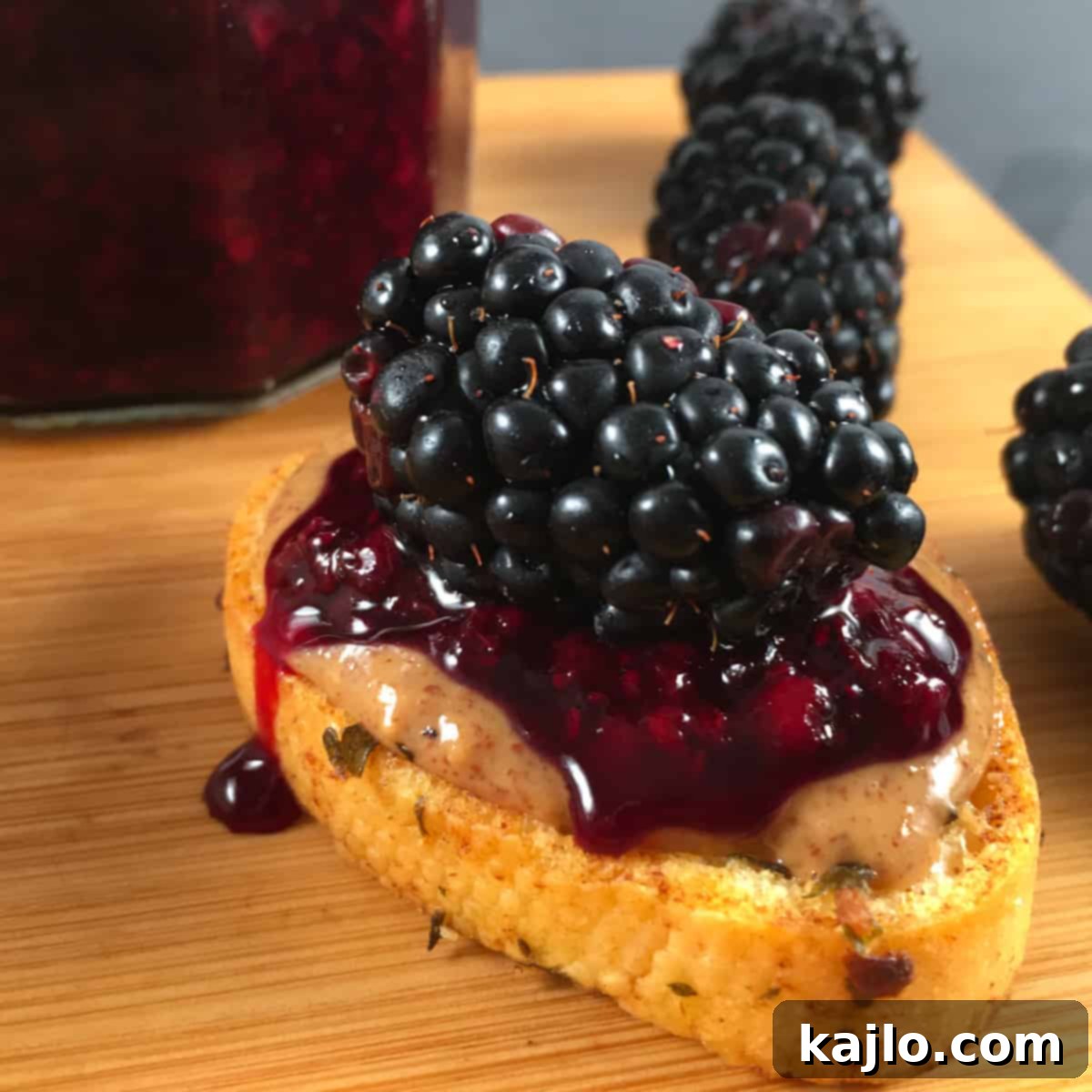
Here are just a few advantages of whipping up a batch of this incredible jam:
- Naturally Low in Calories & Diet-Friendly: This jam is an excellent choice if you’re mindful of your calorie intake or following specific dietary plans like Weight Watchers. By focusing on the natural sweetness of the fruit and using minimal added honey, we create a truly low sugar blackberry jam. Fresh marionberries themselves are only about 80 calories per cup, making this a smart and satisfying option. It’s also naturally gluten-free, and you can easily make it vegan and lower-carb by simply omitting the honey.
- Minimal Ingredients: Once you have your star ingredient – the marionberries – you’ll be delighted to find that only three other common kitchen staples are needed. We believe in keeping things refreshingly simple to let the berry’s flavor shine through without overcrowding it.
- No Pectin Needed: Many jam recipes call for pectin, a gelling agent. If you don’t make jam frequently, pectin isn’t a pantry staple, and buying a whole box for one recipe can feel wasteful. This marionberry jam recipe without pectin cleverly uses chia seeds to achieve a perfect, spreadable consistency, saving you an extra trip to the store and simplifying the process.
- Low in Refined Sugar: Unlike many commercial jams that are laden with refined sugars, this recipe emphasizes the inherent sweetness of the marionberries. The primary sugars come directly from the fruit, complemented by just a touch of natural honey (which can be adjusted or omitted). This makes for a healthier, more naturally flavored spread.
- Packed with Phytonutrients and Fiber: Berries, marionberries included, are nutritional powerhouses. They are rich in health-promoting phytonutrients (antioxidants) and dietary fiber, both crucial for a balanced diet. Incorporating marionberries into your routine is a delicious way to boost your intake of these vital components.
- An Exciting Culinary Discovery: For those living outside of Oregon, the marionberry remains an exotic fruit. This straightforward recipe, coupled with our tips on sourcing marionberries, provides a fantastic opportunity to explore a new, unique flavor and expand your culinary horizons.
- Makes a Thoughtful Homemade Gift: Imagine gifting beautiful canning jars filled with this homemade marionberry jam during the holiday season or for special occasions. It’s a heartfelt, delicious present that truly shows you care. Just remember, since it’s not a traditionally canned jam, it needs to be refrigerated or frozen to maintain its freshness.

🛒 Essential Ingredients for Your Homemade Marionberry Jam
Gathering your ingredients for this delightful marionberry fruit spread is incredibly simple:
- Frozen Marionberries: While fresh are wonderful, frozen marionberries are actually ideal for jam-making. Their cell walls break down beautifully upon thawing and heating, releasing their juices and creating a perfect jam base.
- Chia Seeds: Our star secret ingredient! Chia seeds are exceptional for thickening this jam without the need for traditional pectin. They absorb liquid and create a gel-like consistency, contributing to a rich texture.
- Orange Juice: Freshly squeezed orange juice is highly recommended here. It adds a lovely touch of natural sweetness and a subtle citrus brightness that beautifully complements the marionberry’s deep flavor. While lemon juice is common in jams, orange juice offers a softer, sweeter profile.
- Honey: A natural sweetener that enhances the marionberries’ flavor without overwhelming it. You can adjust the amount to your preference or omit it entirely for a truly sugar-free jam, relying solely on the fruit’s natural sugars.
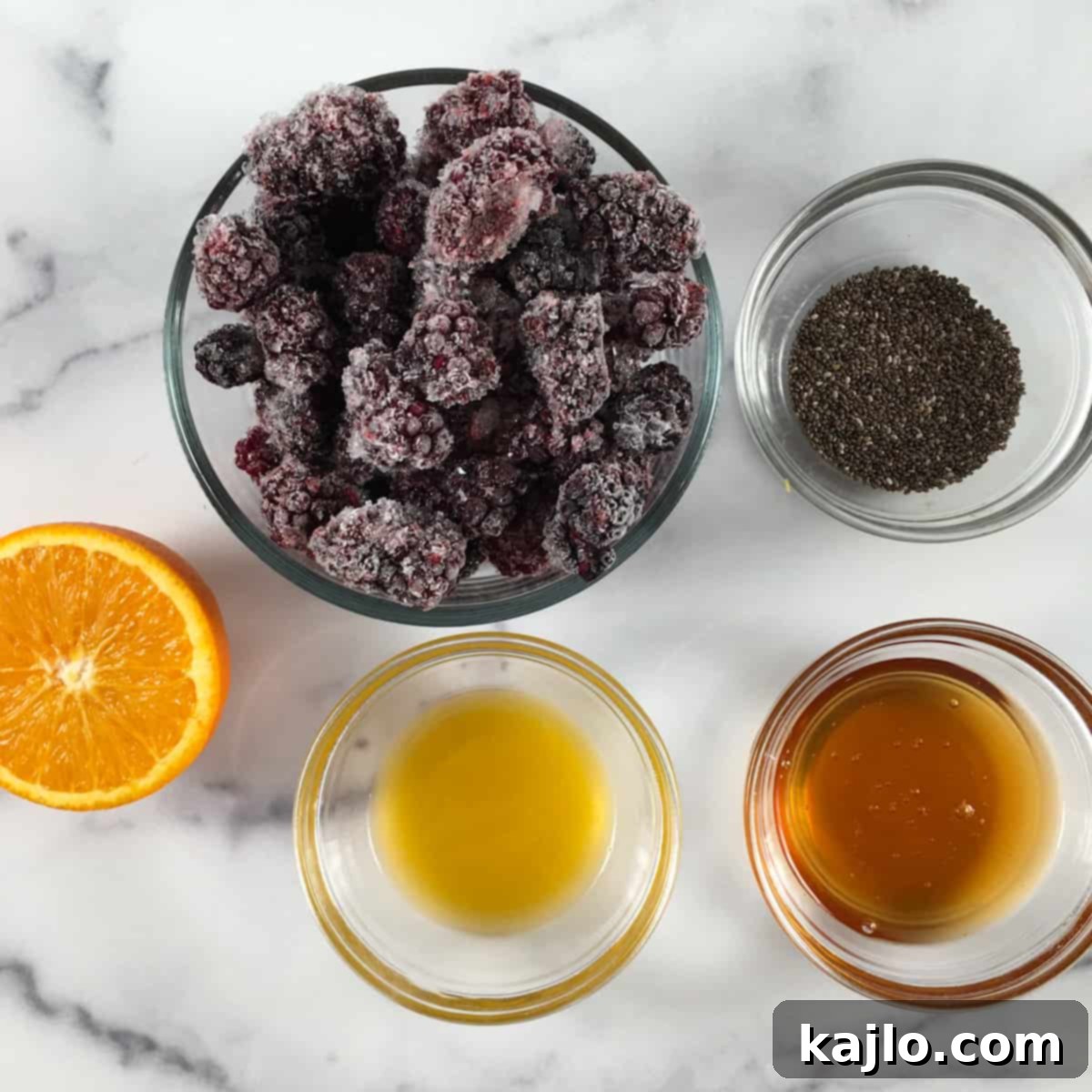
The combination of marionberry seeds and chia seeds gives this berry spread a wonderful, wholesome texture. This jam is delightfully seedy, but in the best possible way, adding to its rustic charm!
As mentioned, while lemon juice is often used in jams for its acidity, I personally find that fresh orange juice provides a more mellow sweetness and a complementary citrus note that truly elevates the marionberry flavor. If you’re squeezing oranges by hand, a manual citrus juicer can be incredibly helpful and make the process much faster and more efficient.
Another invaluable kitchen tool for making this no pectin marionberry jam is a hand potato masher. This simple utensil makes quick work of mashing the softened berries, allowing you to achieve your desired consistency while still leaving some delightful chunks and texture in the jam. If you don’t own a dedicated potato masher, a sturdy fork can certainly do the trick, though it may require a bit more effort and time to mash the thawed frozen berries to your liking.
I personally rely on OXO’s potato masher, which has proven durable and effective over many years of use. Whichever tool you choose, the goal is to gently break down the berries, creating a rich and flavorful base for your homemade preserves.
➕ How to Make Marionberry Jam: A Simple 5-Step Process
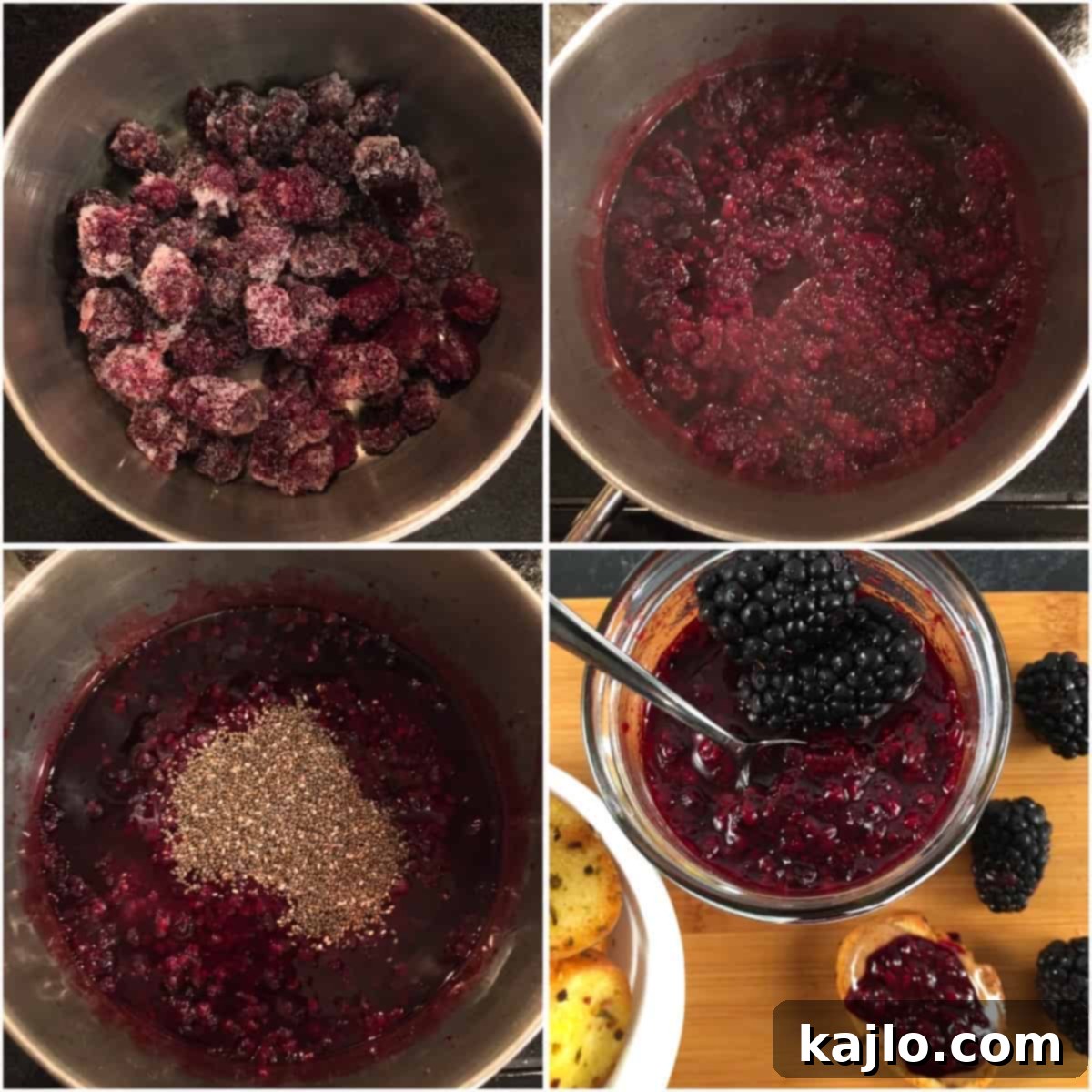
To begin this effortless blackberry jam with no sugar, place your frozen marionberries into a medium saucepan. Place the saucepan over medium heat on your stovetop. Using frozen berries is a brilliant shortcut, as they break down beautifully and release their juices more readily as they thaw and warm.
Allow the fruit to heat for approximately 5-10 minutes, stirring occasionally. During this time, you’ll notice the berries softening and beginning to break down into a mushy consistency. This gentle heating process helps release their natural pectin and juices, which are crucial for the jam’s texture. Once the marionberries are thoroughly warmed and soft, turn off the heat.
Now comes the fun part: mashing! Using a potato masher, or even a sturdy fork, gently mash the berries to your preferred consistency. I personally enjoy a relatively smooth jam with just enough texture from the seeds to remind me of the fresh fruit. However, you can mash them as much or as little as you like, creating a chunkier or finer spread based on your preference. Don’t worry about the seeds – they’re part of the authentic marionberry experience!
Once mashed, stir in the fresh orange juice, honey (if using), and chia seeds. Give it a good mix to ensure everything is well combined. Now, the magic happens as the chia seeds begin to work their thickening power. Let your jam stand at room temperature until it has completely cooled and visibly thickened. This takes a little patience, but it’s crucial for the final texture. Afterward, transfer the jam into clean glass jars and refrigerate it overnight. This overnight chill allows the chia seeds to fully hydrate and the jam to set perfectly.
The next morning, your fresh Oregon marionberry jam will be perfectly set and ready to enjoy! For optimal freshness, any jam you don’t plan to use within 3-4 days should be stored in a freezer-safe container in the freezer. This marionberry freezer jam will maintain its delicious quality for several months, allowing you to defrost a portion whenever you desire a taste of summer. While we call this a “jam,” its thick, spreadable consistency makes it more akin to a rich fruit spread. Whatever you choose to call it, we guarantee you’ll love it!
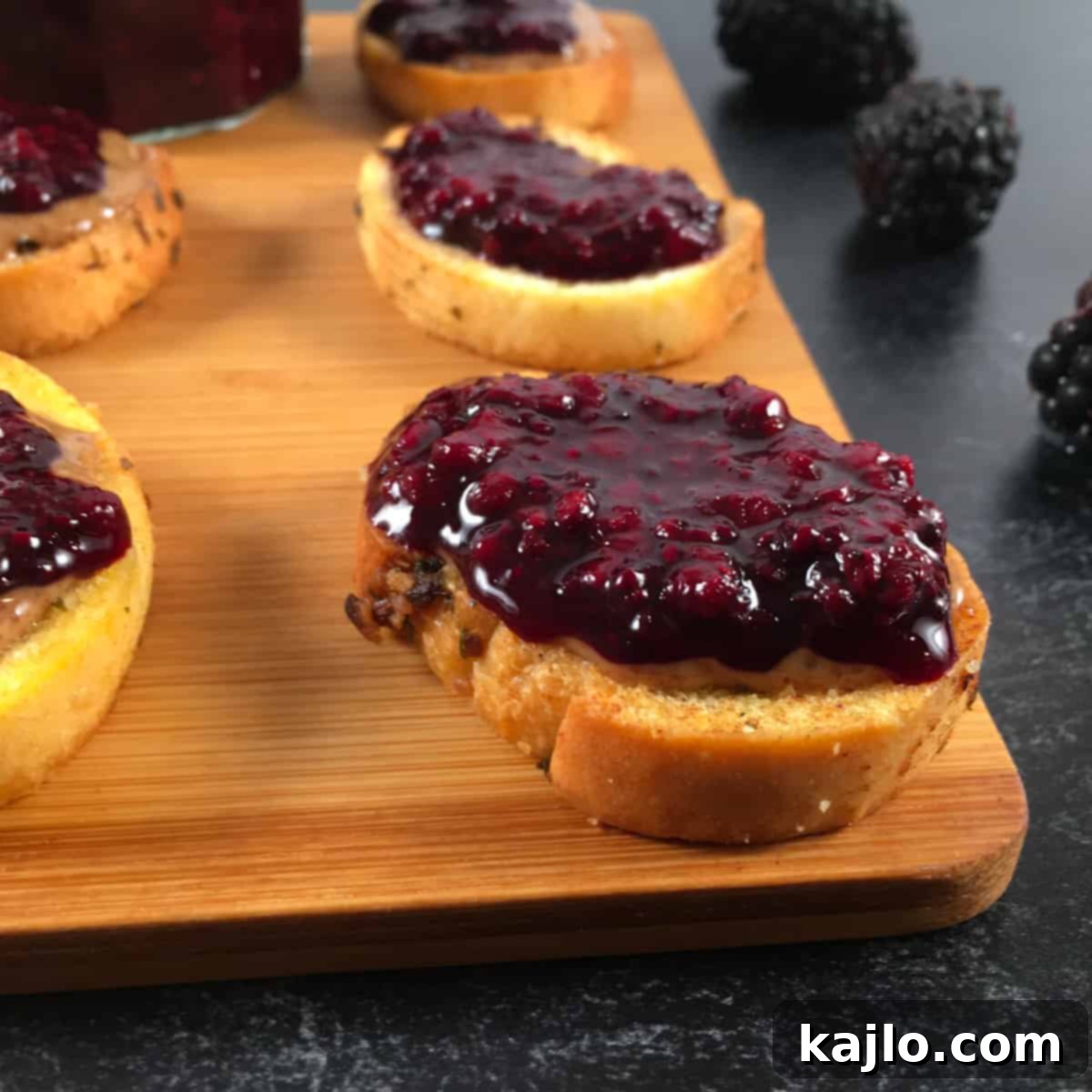
🍓 How to Make Seedless Marionberry Jam without Pectin (and Why You Shouldn’t!)
You might be tempted to create a completely seedless marionberry jam, perhaps by straining the cooked fruit through cheesecloth or using a food mill to achieve a smooth puree. While the idea of a jelly-like texture can be appealing, I strongly advise against making strained jam for several compelling reasons:
- Significant Food Waste: Straining the fruit means discarding a substantial amount of nutritious pulp and fiber. This significantly reduces your overall yield of delicious marionberry jam, making the effort less rewarding.
- Reduced Nutritional Value: The discarded fruit pulp contains a wealth of beneficial phytonutrients and dietary fiber. By straining it out, you’re making your jam less nutrient-dense than it could be, missing out on valuable health benefits.
- More Work and Cleanup: Making strained marionberry jam (effectively, marionberry jelly) adds an extra, messy step to the process. You’ll need to clean a food mill or reusable cheesecloth, increasing your kitchen cleanup time. Opting for whole, mashed marionberries saves time and effort.
- Still Seedy (due to chia!): Since this is a no pectin marionberry jam thickened with chia seeds, the finished product will still have small chia seeds. Even if you remove the marionberry seeds, you’d still have the chia texture. You would also likely need to add a lot more chia seeds to thicken strained marionberry juice compared to the thicker, whole mashed fruit, potentially altering the flavor and texture balance.
- Runny Consistency: My experiments with strained jam consistently resulted in a much runnier consistency compared to the jam made with the whole marionberry pulp. The texture simply wasn’t as rich or as delightfully spreadable, defeating the purpose of a good jam.
Hopefully, these points have convinced you that embracing the seeds in your marionberry jam without pectin is the way to go for the best flavor, nutrition, and ease. However, if you do decide to strain it and find the result not to your liking, don’t despair! The resulting marionberry syrup can be a delicious addition to smoothies, a natural sweetener for yogurt, or a topping for pancakes and waffles (which is exactly what I did with my strained batch!).
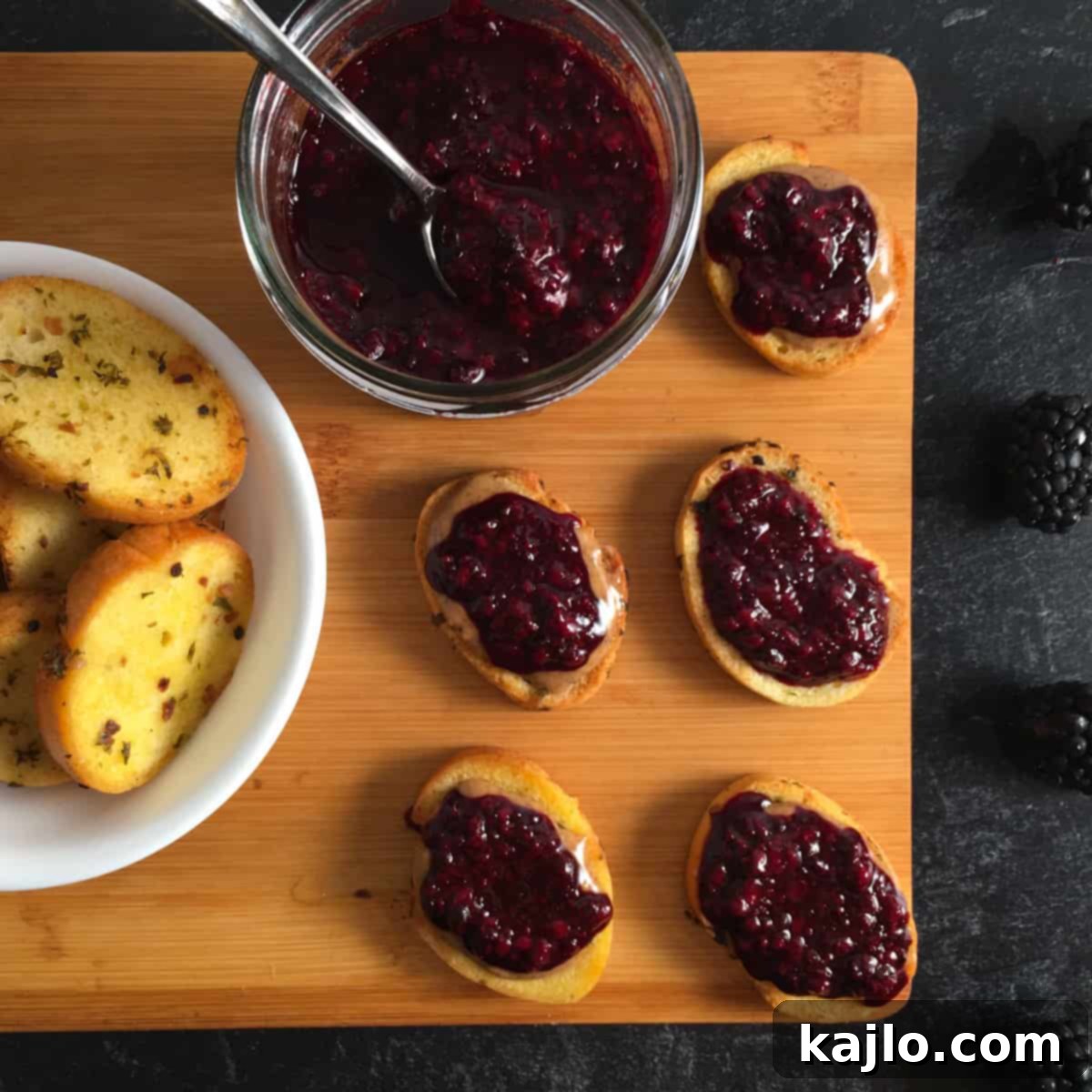
👩🍳 Delicious Ways to Enjoy Your Marionberry Jam
Marionberries are incredibly versatile! You can substitute them for regular blackberries (and sometimes other berries) in almost any recipe you desire. Here are a few ideas to get you started, either using fresh/frozen marionberries or this delightful jam:
- Summer Berry Salad: Elevate your salad with the deep flavor of marionberries.
- Fruit and Yogurt Bowls: Swap out standard blackberries for marionberries to add a gourmet touch to your breakfast or snack.
But how best to use your freshly made marionberry jam? In my humble opinion, these seed-packed, richly flavored preserves are the ultimate ingredient for a gourmet peanut butter and jelly sandwich. A marionberry PB&J would undoubtedly make lunch the highlight of my day!
For another simple yet satisfying idea, spoon your marionberry jam over your favorite yogurt. Pair it with some crunchy granola and a dollop of almond butter for a wholesome and delicious meal. Since I consciously limit my added sugar intake, I particularly enjoy this jam with plain Greek yogurt or skyr. Its natural sweetness and vibrant flavor perfectly complement the tanginess of unsweetened yogurt. It would also be fantastic over certain flavored yogurts, such as lemon, orange, or vanilla, for an extra burst of fruitiness.
To integrate this marionberry jam recipe into a complete and energizing breakfast, consider stirring it into your overnight oats. Try these Overnight Oats with Frozen Fruit, substituting some of the frozen fruit with generous spoonfuls of your marionberry chia jam for a unique twist.
For a more decadent, dessert-like breakfast or brunch, this recipe can easily double as a marionberry compote. Serve it warm alongside fluffy waffles or golden pancakes. For an extra special treat, add a dollop of whipped cream (sugar-free if you prefer), a drizzle of maple syrup, and a sprinkle of fresh orange zest on top. The combination of flavors is truly exquisite and guaranteed to impress!
Frequently Asked Questions About Marionberries & Homemade Jam
When are marionberries in season?
The peak season for fresh Oregon marionberries typically runs for a short but sweet window from mid-July to mid-August. If you’re visiting Oregon during these months, it’s the perfect opportunity to find these exquisite berries fresh at local markets. Fortunately, for those of us outside the Pacific Northwest or looking to enjoy them year-round, frozen marionberries are readily available and maintain their delicious flavor perfectly for jam making.
What do marionberries taste like?
Marionberries are truly a taste sensation, offering a flavor profile that is both complex and incredibly rich. They stand apart from your average grocery store blackberry, boasting a deeper, more intense berry essence. This unique taste is precisely why they’ve earned the monikers “King of Blackberries” and the “Cabernet of Blackberries.” They strike a perfect balance between tartness and sweetness, with a slightly firmer texture than typical blackberries. Imagine a blackberry, but with an added layer of sophisticated berry notes – that’s the marionberry experience!
Where to Buy Marionberries (if you don’t live in Oregon)
If you reside in certain areas of Oregon, particularly Marion County and its surroundings, you might find fresh or frozen marionberries in mainstream grocery stores during their short season. However, for those outside the Pacific Northwest, purchasing marionberries online is typically the most convenient option. It’s important to note that shipping frozen berries can sometimes add significantly to the cost compared to local procurement.
I often source my frozen marionberries from Northwest Wild Foods. Keep in mind that marionberries, like many specialty fruits, are often seasonal even when frozen, so availability might vary throughout the year. Northwest Wild Foods is also a fantastic resource for discovering other lesser-known berries, edible mushrooms, nuts, and sustainable seafood. It’s easy to get lost in their selection, so be warned, fellow foodies – you might find yourself adding more than just marionberries to your cart!
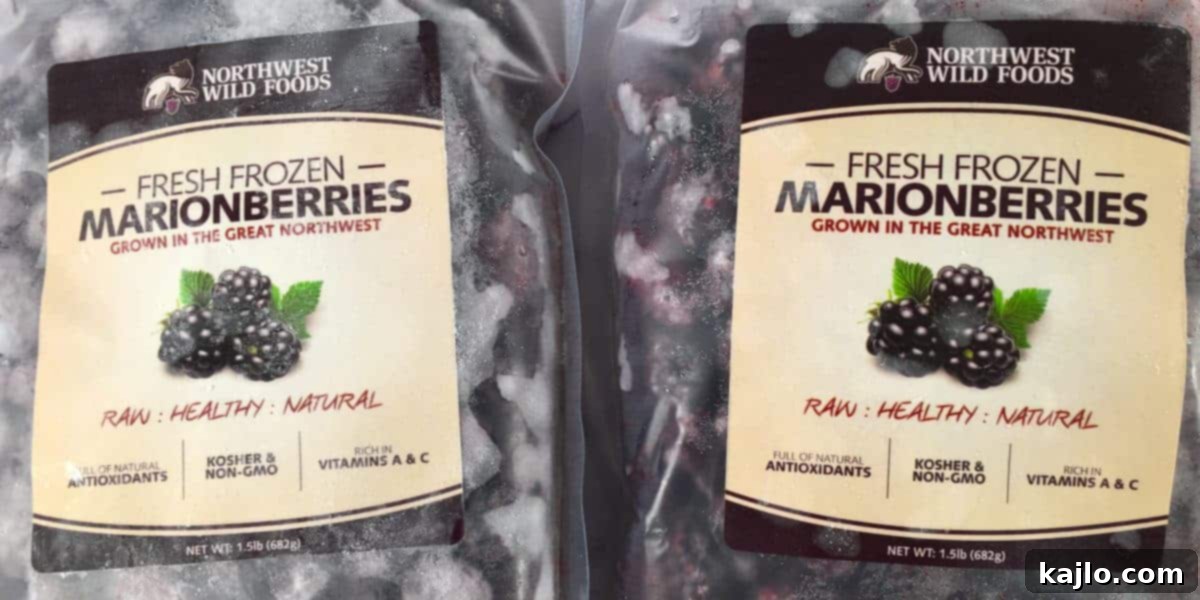
Where to Buy Marionberry Jam (if you prefer not to make it)
If sourcing fresh or frozen marionberries proves too challenging, or if you simply prefer the convenience, finding pre-made marionberry jam can be much easier, especially online. Numerous artisanal producers offer a variety of options to suit different dietary preferences. Here are a few notable selections:
- Misty Meadows Sugar Free Marionberry Spread: This spread features a simple ingredient list: marionberries, pectin, and apple juice. It’s an excellent choice for a premade, no-added-sugar marionberry jam, and the charming crock it comes in is an added bonus.
- Oregon Growers Marionberry Fruit Spread: For those who appreciate a more classic jam with sugar and pectin, this option is a fantastic choice. It’s also Non-GMO Project verified, though it’s worth noting that marionberries and other blackberries are not genetically modified crops in the U.S., so all marionberries would inherently be non-GMO.
- Big Foot Toe Jam Oregon Marionberry Jam: This jam certainly wins for the most amusing name! If you prefer a seedless marionberry jam, despite the advice above, this is an option for you. It’s another traditionally sweetened jam, perfect for those who enjoy a richer, sweeter fruit spread.
How long does homemade marionberry jam last?
Because this is a low-sugar, no-pectin jam, it has a shorter shelf life than traditional heavily sugared, canned jams. This homemade marionberry jam will last about 1-2 weeks in the refrigerator. For longer storage, it’s best to freeze it. Properly stored in a freezer-safe container, your marionberry freezer jam can last for up to 6 months, ensuring you have a taste of summer whenever you need it.
Can I substitute other berries in this recipe?
Absolutely! While marionberries offer a unique flavor, this recipe is highly adaptable. You can use regular frozen blackberries, raspberries, blueberries, or even a mix of your favorite berries. Keep in mind that the flavor profile and final consistency might vary slightly depending on the water content and sweetness of the berries you choose. You might also need to adjust the amount of honey or orange juice to taste.
👨🍳 More Berry-Filled Recipes You’ll Love
My love for berries knows no bounds! They are incredibly tasty, brimming with essential nutrients, and perfectly suited for a variety of diets, including low-calorie and low-carb plans. It’s no wonder that my site features an abundance of berry-centric recipes!
If you’re like me and can’t get enough of these delightful fruits (the edible ones, of course!), then you’re sure to enjoy these other “berrylicious” recipes:
- Chocolate Strawberry Banana Smoothie: A creamy, satisfying smoothie with no added sugar.
- Strawberry Cucumber Smoothie: A refreshing and hydrating blend perfect for any time of day.
- Healthy Overnight Oats for Weight Loss: A convenient and nutritious breakfast option featuring blueberries.
- Strawberry Banana Nice Cream: A guilt-free, delicious frozen treat that tastes just like ice cream.
- Frozen Cod in Air Fryer with Strawberry Kiwi Mango Salsa: A savory dish brightened with a vibrant fruit salsa.
- Orange Chicken Salad with Strawberries: A delightful combination of sweet and savory flavors.
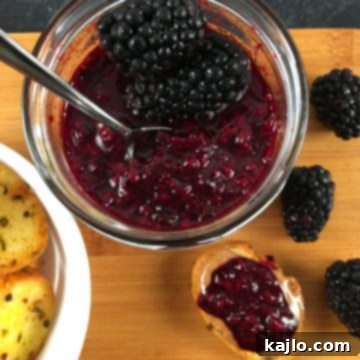
Marionberry Jam Recipe without Pectin (Low Sugar)
By Summer Yule
Print Recipe
Pin Recipe
10 mins
10 mins
20 mins
Slow Food DIY
American
12
31
kcal
Ingredients
-
2
cups
marionberries
(fresh or frozen) -
2
tablespoons
honey -
1
tablespoon
orange juice
(freshly squeezed) -
1
tablespoon
chia seeds
Love this recipe?
Please leave a comment below 😊
Instructions
- 1. Place the frozen marionberries (or blackberries) in a medium saucepan over medium heat on the stovetop. Heat the fruit for 5-10 minutes, allowing it to soften and break down. Stir occasionally to prevent sticking and ensure even cooking.
- 2. While the berries are heating, squeeze the juice from half an orange. You will need one tablespoon of fresh orange juice for this recipe. Using fresh juice will yield the best flavor.
- 3. After the marionberries have cooked down and become very mushy, remove the saucepan from the heat. Use a potato masher or a fork to mash the berries to your desired consistency. For a smoother jam, mash thoroughly; for a chunkier spread, leave some larger berry pieces. You’ll still have plenty of texture from the natural berry seeds.
- 4. After mashing, stir in the honey, fresh orange juice, and chia seeds until well combined. Let the jam stand at room temperature until it has fully cooled and begun to thicken. Then, transfer the jam into clean glass jars and refrigerate overnight. This allows the chia seeds to fully gel and the jam to set beautifully.
- 5. In the morning, your fresh Oregon marionberry jam will be ready to enjoy! For optimal storage, any jam you do not plan to consume within 3-4 days should be placed in a freezer-safe container and stored in the freezer. Your homemade marionberry freezer jam will stay fresh for months.
- Hot tip! If the marionberry jam hasn’t thickened sufficiently after refrigerating overnight, simply stir in an additional teaspoon of chia seeds and refrigerate again for another 8-12 hours. This will help achieve the perfect consistency.
Equipment
- Citrus Squeezer
- Potato Masher
- 4-Ounce Canning Jars
Notes
💭 Expert Tips from Dietitian Summer Yule
This is a level 1 recipe (may help support fat loss). Berries are a naturally low-calorie food that aligns with most dietary patterns aimed at weight loss, including low-carb and keto diets. This low sugar marionberry jam offers an easy and flavorful way to incorporate more fruit into a variety of dishes.
The overall dietary impact of this jam depends largely on what it’s served with. For a lower-calorie, satiating option, try pairing it with high-protein, low-fat Greek yogurt.
If you’re looking for a higher-energy (i.e., higher-calorie) meal, this jam makes a fantastic addition to a sandwich generously spread with nut butter, ideally on whole-grain bread for increased fiber. Many more creative serving ideas are shared throughout this article.
If you’re accustomed to heavily sweetened foods, this low sugar jam might initially seem less sweet. In that case, you can always add a non-nutritive sweetener, maple syrup, or a bit more honey to taste. Please remember that adding more sweeteners will alter the nutritional information provided.
Keep in mind that added sugars, including natural options like honey and maple syrup, can quickly increase the calorie content. In my professional opinion, it’s often best to embrace the natural sweetness and aim for a truly sugar-free marionberry jam. I’ve personally made and thoroughly enjoyed this marionberry jam without any added honey, though I recognize this preference isn’t universal.
Nutrition information is for one serving of the recipe. (The total yield is 1.5-2 cups of jam.)
nutrition info disclaimer
All recipes on this website may or may not be appropriate for you, depending on your medical needs and personal preferences. Consult with a registered dietitian or your physician if you need help determining the dietary pattern that may be best for you.
The nutrition information is an estimate provided as a courtesy. It will differ depending on the specific brands and ingredients that you use. Calorie information on food labels may be inaccurate, so please don’t sweat the numbers too much.
“To taste” means to your preferences, which may have to be visual to follow food safety rules. Please don’t eat undercooked food x
Nutrition
Calories:
31
kcal
Carbohydrates:
8.3
g
Protein:
0.6
g
Fat:
0.3
g
Fiber:
1
g
Vitamin C:
5.5
% DV
Calcium:
1.8
% DV
Iron:
1.5
% DV
blackberry jam low sugar, blackberry jam recipe without pectin, how to make marionberry jam, low sugar marionberry jam, marion blackberries, marionberries, marionberry jam, marionberry jam low sugar, marionberry jam recipe, marionberry jam recipe without pectin, Oregon marionberry jam
Shop our cookbook!
Easy Air Fryer Recipes for One
Burning your air fryer recipes?
Here’s how to fix it!
Join our community! Subscribe for all of the latest and greatest recipes, and follow me on Facebook, Pinterest, Instagram, and YouTube!
